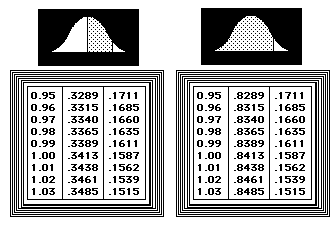|
Conventional and Alternate
Assessment Models
|
Mastery Learning vs. Bell Curve

Bell-curve believers' answer to Mastery Learning: Your first assignment of Mastery Learning is to master the meaning of the above bell curves.
- John Carroll (1963):
- the focus of instruction should be the time required for different students to learn a given amount of material.
- Teachers should allow more time and provide more and better instruction for slower learners.
- Benjamin Bloom (1968)
- the bell-curve approach causes both teachers and students to expect only a third of all students will adequately learn the materials, and this expectation leads to a self-fulfilling prophecy.
- Our basic tasks is to determine what we mean by mastery of subject and to search for the methods and materials which will enable the largest proportion of our students to attain such mastery.
- Computer-assisted instruction offers self-paced learning for individual differences.
- A nation at risk (National Commission on Excellence in Education, 1983): Standards of American students has been declining.
- In 1984, 65% of Americans surveyed indicated that they favored a standardized test as a prerequisite for obtaining a high school diploma; only 29 % opposed (cited in Schaeffer, 1986).
- Expectations have been reduced not only for students or schools, but also for the educational system as a whole. Grade inflation occurs i.e. Even as the measuremed achievement of American students has fallen, the average grades they are given have risen. Thus, it takes less knowledge to get an "A" in the average school or college today than it did 25 years ago (Farley, 1990).
Portfolio Assessment
- The collection of student portfolios, sample of student work over an extended period.
- Giving students a role in determining the contents of their portfolios may provide greater incentive to learn and a greater sense of responsibility for their own learning.
Performance Assessment
- Demonstrations of knowledge or skills in real life.
- Shows not only what they know, but also what they can do.
- Standardized (norm-referenced) testing make teachers focus on a narrow range of topics and items that are most likely to appear on the tests. In theory, performance assessments require a broader understanding of the subject matter.
- Different performance assessments produced very different patterns of scores, and student scores were still more closely related to student aptitude than to what students were actually taught. (Slavin, 1994)
Negotiated Assessment
- Focus on reporting students' progress to parents
- Customize instruction to individual needs and expectations based upon negotiation.
Responsive evaluation
- specify instructional objectives and outcomes.
- to gather data from naturally occurring setting (qualitative).
- to observe, interact, and participate in the learning environment
- a close relationship with the students.
Authentic Assessment
Wiggins (1989):
- They are designed to be truly representative of performance in the field; only then are the problems of scoring reliability and logistics of testing considered.
- More attention is paid to the teaching and learning of the criteria to be used in the assessment.
- Self-assessment plays a greater role than in conventional testing.
- The students are often expected to present their work and defend themselves publicly and orally to ensure that their apparent mastery is genuine.
Questions:
- What are the differences and similarities between performance and portfolio assessments?
- Do you think mastery learning, performance assessment, or portfolio assessment can overcome the problems introduced by standardized tests (the bell-curve approach)?
- Turbill asserted that responsive evaluation is a new paradigm integrating portfolio and negotiated assessments. How can these two approaches fit into responsive evaluation?
References
Bloom, B. S. (1968). Learning for mastery. Evaluation Comment, 1(2), LA: Center for the Study of Evaluation of Instructional Program, University of California.
Carroll, J. B. (1963). A model of school learning. Teacher College records, 64, 723-733.
Farley, J. E. (1990). Sociology. Englewood Cliffs, New Jersey: Prentice Hall.
National Commission on Excellence in Education. (1983) A nation at risk: The imperative for educational reform. Washington, DC: U.S. Government Printing Office.
Schaeffer, R. T. (1986). Sociology. New York: McGraw-Hill Book Company.
Slavin, R. E. (1994). Educational psychology: Theory and practice. Boston: Allyn and Bacon.
Wiggins, G. (1989). Teaching to the (authentic) test. Educational Leadership, 46, 41-47.
Navigation
Simplified Navigation
Table of Contents
Search Engine
 Press this icon to contact Dr. Yu via various channels
|
